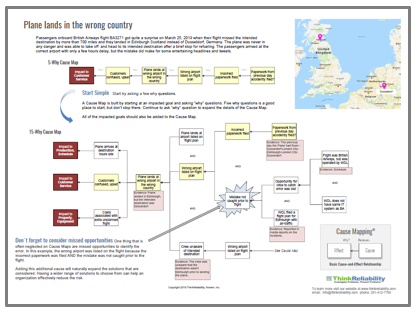Passengers onboard British Airways flight BA3271 got quite a surprise on March 25, 2019, when their flight missed the intended destination by more than 700 miles and they landed in Edinburgh, Scotland instead of Dusseldorf, Germany. The plane was never in any danger and was able to take off and head to its intended destination after a brief stop for refueling. The passengers arrived at the correct airport with only a few hours delay, but the mistake did make for some entertaining headlines and tweets.
Looking at the root cause analysis
The pilots and flight crew believed the plane’s correct destination was Edinburgh and were unaware of the mistake until passengers started asking questions after an onboard announcement welcomed them to Scotland. After this type of mistake is made, it is natural to ask how something like this could happen.
ThinkReliability investigates incidents using the Cause Mapping method of root cause analysis which is an intuitive method that visually lays out all of the causes that contributed to an issue. A Cause Map is built by starting at an impacted goal and asking “why” questions. For this example, let’s consider the customer service goal first. Customer Service was impacted because passengers were confused and presumably not very happy after landing at the wrong airport. More boxes could be added by continuing to ask more “why” questions.
A 5-why Cause Map is shown below.

Obviously, a thorough investigation into this incident would want to understand how the paperwork from the previous day was filed instead of the correct paperwork, but no information was released about how this mistake was made so we document the possible cause on the Cause Map with a question mark (?). The Cause Map can quickly be updated if and when additional information becomes available.
Expanding the Cause Map
A 5-why Cause Map is a good starting place, but the Cause Map should be expanded to include all relevant information based on the severity of the incident. All of the impacted goals should be added and any other details that are available should be documented. In this case, there was an impact to the schedule goal because the plane arrived late to its destination and the property goal was impacted because of the costs associated with an extra unplanned flight.
One thing that is often neglected on Cause Maps are missed opportunities to identify the error. In this example, the wrong airport was listed on the flight because the incorrect paperwork was filed AND the mistake was not caught prior to the flight. Adding this additional cause will naturally expand the solutions that are considered. It is clearly important to discuss solutions that could reduce the risk of the wrong paperwork being filed, but also considering an additional review of the paperwork or discussing how to improve safeguards that are already in place could also improve the overall reliability of the work process. Having a wider range of solutions to choose from can help an organization effectively reduce the risk by mitigating more causes
Importance of adding detail
With an incident like this one where an error occurred such as the wrong paperwork being filed, it can be tempting to say that the mistake was THE reason this incident occurred or to call it the root cause (singular).
Sometimes organizations like to label this as “human error” and preventing a similar error or even punishing the individual who made the mistake becomes the focus of the investigation. A Cause Map is intended to capture ALL of the causes (plural) that contributed to an issue. By focusing on identifying all of the causes, it naturally widens the solutions that are considered and gives an organization more options to reduce the risk of a problem recurring.












